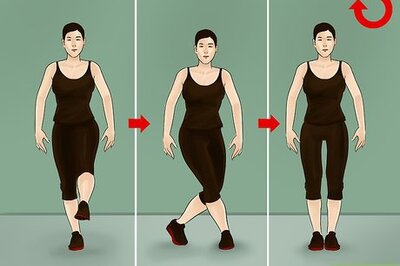
views
The United Nations was founded at the end of the Second World War “to save succeeding generations from the scourge of war, which twice in our lifetime has brought untold suffering to mankind” and “towards that end to unite our strength to maintain peace and security.” Seventy five years later, we are being ravaged by another scourge of war — the COVID-19 pandemic — and we find ourselves ill equipped as an international comity of nations to win over it. It has shaken our national and international economic, social and political order to its foundations. It has also exposed the weaknesses of the global health and biosecurity system and the overall peace and security architecture. It will require our going back to the drawing board and reimagining the world as we did in 1945, for the survival of humankind.
“It’s an ideal weapon because it only destroys people. It’s a virus — airborne, indestructible, self-perpetuating, multiplying beyond our calculations — and all life will cease to exist everywhere. Nothing can stop the Satan Bug.” Thus, did Dr Gregor Hoffman, the insane bioscientist in the 1965 Alistair MacLean science fiction book and movie The Satan Bug, ominously but not inaccurately describe a biological weapon. Despite being such a cataclysmic force, biological weapons, unlike other weapons of mass destruction or WMD — nuclear and chemical — have escaped public consciousness and scrutiny.
Biosecurity as a defence against biological warfare, bioterrorism, and pandemics has been underemphasised in national and international security agendas. The advent of the COVID-19 pandemic, originating in China, has suddenly awakened the world to the destructive potential of a pandemic and has painted a vivid picture of what a biological war would look like. It has taught us many lessons which India and the world would do well to learn.
Significance of the Covid War
Compared to some other pandemics, like the Spanish Flu and smallpox epidemics of the 20th century and the bioweapons used in the Second World War, the death rate of COVID-19 is not high — 2-8%. COVID-19 has, however, not only hurt the country of origin, but has gotten exported to 212 countries and territories due to China’s extensive global economic and human footprint and connectivity. An alleged lack of transparency and absence of early warning as to its virulence is said to have contributed to COVID-19’s intractable global spread. With 3.9 million infections and 270,000 deaths and counting, it has been labelled a quasi-biological war in its scale, scope, duration, and impact.
UN Secretary General, António Guterres, has called this pandemic the biggest crisis since World War II and some, like Bill Gates, have termed it a World War by other means. Most leaders around the world refer to their strategies to prevent and respond to COVID-19 as an existential war and see themselves as health and biosecurity generals. Understanding what a biological holocaust would portend has jolted us into prioritising biosecurity in national and international security in this turnpike year of 2020.
Menace and Deception of Bioweapons
Covid-19 has shown that we have underestimated the insidious nature of and the menace posed by biological weapons to humanity. It is difficult to anticipate new, highly infectious, and deadly bioagents like COVID-19. The absence of immediate bio-defences and the timelag in finding treatment(s) and vaccine(s) enables the invisible enemy to inflict high morbidity and mortality. The latency period and mutation into virulent and different strains, along with the chances of a recurrence in waves, makes disease detection and control more challenging.
Mass contagion and efforts to contain it, including through the Great Lockdown, has brought even the most powerful countries to their knees and economies to a grinding halt. It has pushed robust democratic societies into turmoil and has led governance into crisis. The pandemic has generated a psyche of fear, uncertainty, and helplessness among people everywhere.
Particularly worrisome is that any state or non-state actor or entity with hostile intent could develop and wield a bioweapon undetected, as production facilities require little space and microbial agents as well as technologies are easy to procure. The relative low cost and ease of developing bioweapons, including by rogue regimes and private labs, and the possibility of stealthy deployment of bioagents — through animal or human carriers or other special purpose delivery vehicles — raises the stakes.
We, therefore, need to identify extant and potential bioagents that exist in nature or that are human engineered to become dangerous bioweapons. Epidemiologists have categorised these as:
A — most lethal and transmissible,
B — moderately threatening, and
C — emerging bio-agents engineered for mass dissemination in the future.
We must build our capacities to anticipate, detect, and defend ourselves in a timely manner from these dangerous bioagents, which will be a complex, resource intensive, but necessary undertaking.
Additionally, to respond to unexpected and emerging biological threats, all normal labs, medical facilities, and hospitals should be made re-purposable so that they can transform into a seamless infrastructure for quick and reliable testing and therapeutics development. Public-private partnerships should be forged for vaccine development, testing, and deployment within telescoped timeframes. Our biodefence/vaccine stockpiles for existing and eradicated diseases, like smallpox — which could be used as a bioweapon by Satanic entities in the future — should be replenished. More evolved IT-based telemedicine and health status surveillance technologies, information networks, and contact tracing apps are more enduring bio and health security measures.
Dilemmas of Dual use bio agents
Micro-organisms and their related infrastructure are essentially dual in nature — their use in nature and in research and development for bio-defence, can easily be re-oriented for bio-offence. The Biological and Toxin Weapons Convention (BWTC) permits states to produce, use, and stockpile biological agents for medical, pharmaceutical, and defensive purposes; and in small quantities for prophylactic, protective, and other peaceful purposes. We need to overcome this “dual use” challenge that comes with the territory of scientific and technological development, and reengineer verification and certification systems for effective differentiation between bio-defence and bio-offence. This will also be addressed when a credible verification and compliance system under the BWTC is established.
There is only a thin line between biological weapons — a WMD deliberately wielded — and a COVID-19 type pandemic caused by spontaneous or accidental virus release, in terms of their impact and the response required. Biosecurity and health security are two sides of the same coin. Those consciously infecting people with harmful intent are bio-terrorists. Those flouting health security norms in communities are morally culpable of the same harm. But the stigmatisation of those spontaneously infected or those on frontline duty, like those dubbed the “COVID-19 warriors”, is unconscionable and counter-productive. Citizens must be vigilant, responsible, empathetic, and perform their civic duty during a war against a pandemic — whatever the origin.
Military force and biosecurity
When we speak of wars, our first thought is of the armed forces. A war against a pandemic impacts the military in less obvious ways than a conventional war would. Bioweapons and pandemics considerably affect the preparedness of the armed forces to deal with WMDs, as well as conventional and terrorist threats. The double jeopardy of the armed forces getting weakened by the disease — witness the infections among police, border security forces, CRPF, army, navy, and airforce in India — and their being deployed for pandemic response can pose major security challenges. Reports of increased terrorist mobilisation and regrouping on our border with Pakistan, and of infected COVID patients being infiltrated across the border are proof. COVID-19 triggered defence spending cuts affect defense preparedness too, as does economic infrastructure degradation.
It is uncanny how the Chinese People’s Liberation Army (PLA) officers Qiao Liang and Wang Xiasu’s book, on the “Unrestricted Warfare” strategy, seems to apply to the impact of bioweapons/pandemics on national security. We would contend with the “alternative methods” of war by disease being employed with the same or greater destructive force than military warfare, with unprecedented and multidirectional impact. Boundaries between military and non-military assets, operations and personnel, and between weapon and non-weapons are dissolved. Victories are won on and off the “battlefield”, with economics and politics becoming the battlefields of an unconventional modern war. This War is fought simultaneously in different spaces — local, national, regional, and global. Deviating from the centre and finding the enemies’ weak point is a key strategy — in this case sickening an entire population in a democracy — when a technologically stronger adversary is to be conquered.
Our bio-defence against such “unrestricted warfare” must take its cues from these basic premises. It must be agile and “multidirectional”, and must straddle the civilian and military, the economy and society, technology and communication, the local and global. While keeping our military guard up on all fronts, we need to incorporate biosecurity into our overall defence, security, and counterterrorism strategies and planning. There needs to be a critical and predetermined role for our defence infrastructure and its logistical capacity to meet any bio/health security challenge on a war footing.
A dedicated National Rapid Deployment Biosecurity Force comprised of the armed forces, the police, and health responders — who are well-protected and equipped against contagion — should be set up with frontline, security and pandemic related, disaster reduction, relief and response functions. China’s deployment of the PLA for lockdown enforcement and vaccine development is instructive even with our systemic differences.
These lessons about pandemics/bioattacks being in the nature of “unrestricted warfare” and the China experience will no doubt inform our current fight against the COVID pandemic. It must also shape preparedness strategies for fending off and responding to biological attacks from both hostile states and bioterrorists in the future and prompt a churning in current military doctrines and security architectures — nationally and internationally.
The author was former assistant secretary general, United Nations. Views expressed are personal. This article first appeared in ORF.


















Comments
0 comment